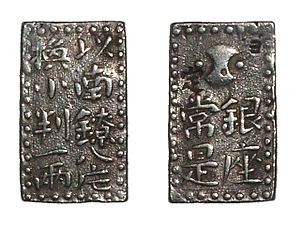Meiwa facts for kids
Meiwa (明和) was a special time period in Japan called a Japanese era name (年号,, nengō). Think of it like a way to count years, similar to how we use BC or AD, but specific to Japan's history. This period came after the Hōreki era and before the An'ei era.
The Meiwa era started in June 1764 and ended in November 1772. During this time, Japan had two rulers: Go-Sakuramachi-tennō (後桜町天皇) and Go-Momozono-tennō (後桃園天皇). The name Meiwa itself means "Radiant Harmony," which sounds peaceful!
Key Events of the Meiwa Era
Many important things happened during the Meiwa era:
- 1766 (Meiwa 3): There was a plan to change the leader of the government, known as the Shogun, but it did not succeed.
- 1770 (Meiwa 7): A powerful typhoon hit Kyoto and destroyed the newly built Imperial Palace, which was the home of the Emperor.
- 1770 (Meiwa 7): A very bright comet, called Lexell's Comet, appeared in the sky. It had a super long tail and could be seen throughout the summer and autumn nights.
- 1770 (Meiwa 7): This year marked the beginning of a long period of dry weather in Japan, which lasted for 15 years.
- 9 January 1771: Empress Go-Sakuramachi decided to step down from her role as Empress. Her nephew, Emperor Go-Momozono, then took over as the new ruler of Japan. His position was made official with special ceremonies.
- 29 February 1772 (Meiwa 9): A massive fire, known as "The Great Meiwa Fire," broke out in Edo (which is now Tokyo). It was one of the biggest and most destructive fires in the city's history.
- 2 August 1772 (Meiwa 9): A huge storm hit the Kantō region of Japan. It caused severe floods and damaged many crops, which meant less food for people.
- 17 August 1772 (Meiwa 9): Another strong storm struck Edo, destroying about 4,000 houses.
Related Pages
- National Diet Library, "The Japanese Calendar" -- historical overview plus illustrative images from library's collection
| Meiwa | 1st | 2nd | 3rd | 4th | 5th | 6th | 7th | 8th | 9th |
|---|---|---|---|---|---|---|---|---|---|
| 1764 | 1765 | 1766 | 1767 | 1768 | 1769 | 1770 | 1771 | 1772 |
| Preceded by: Hōreki |
Era or nengō: Meiwa |
Succeeded by: An'ei |

All content from Kiddle encyclopedia articles (including the article images and facts) can be freely used under Attribution-ShareAlike license, unless stated otherwise. Cite this article:
Meiwa Facts for Kids. Kiddle Encyclopedia.

